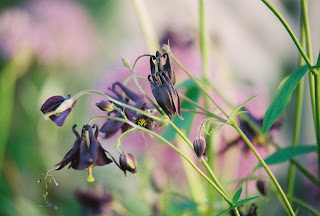Sometimes it feels like
we’ll never get ahead of opportunistic nonnative plants. Especially with woody
plants like Japanese knotweed (Fallopia japonica), it seems once they’re in your garden, you may never see the end of
them.
In his book Gaia’s Garden, Toby Hemenway argues that
opportunistic plants grow where we’ve given them an opening in disturbed ground
and will naturally die off as stable plant communities take over (Hemenway
prefers the term opportunistic to invasive, which he considers too emotionally
loaded. I’m using his terminology). This is a nice idea, but considering how much
Japanese knotweed I see in the course of a week’s driving, I wondered how
likely Hemenway’s scenario was in my area.
 | |
| This Japanese knotweed's underground rhizomes could be as much as 60 feet long. It propagates by seeds but is also capable of regenerating from root or stem fragments. |
This week I was pruning dead branches out of a dwarf mugo pine, (Pinus mugo 'Paul's Dwarf') planted eighteen years ago that is now partially shaded by a nearby magnolia. It occurred to me that this could be an example of Hemenway’s point. The branches that were in full shade were dead, with clinging brown needles, whereas the side of the little tree that was still in sun was looking good and producing green needles. I hadn’t shaded out this pine on purpose, I’d just failed to imagine how big the two trees were going to grow and planted them too close together.
 |
| Mugo pine reaching for sunlight outside the shade of a taller magnolia |
If
the magnolia had cast its shade over an unwanted shrub like Japanese knotweed,
I suppose it too would have dwindled. The problem, Hemenway points out, is that
suburban landscapes, even our parks, offer so many sunny edges that favor
fast-growing plants like the knotweed.
Of
course, shade isn’t the only condition that discourages opportunistic plants. The
goal is to replace a plant that you don’t want with one, or ideally some, that
you do. If you just remove the offender, you leave open soil for opportunists
to take over again. Growing together, a group of native plants that have
evolved to cooperate can succeed in grabbing the resources an opportunist needs
to survive, not just sunlight but also water, soil nutrients, and room to grow.
While
I wait for my growing collection of native plants to knit themselves into
anti-opportunist communities, I’m still cutting a couple of knotweeds at the
fence line to the ground every couple of weeks, hoping they’ll eventually run
out of stored energy and give up.
 |
| I cut it down, but this deceptively frail-looking Japanese knotweed, center, keeps coming back up. Will encroaching smooth Solomon's seal help to curb its growth? |







